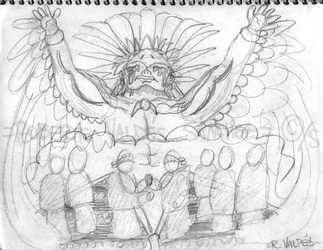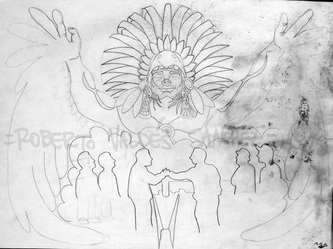"Paz" (1996) – color pencil
Gangs are a symptom of society’s failure to meet the needs of its people. Minority communities are disproportionately affected due to systemic inequities that stifle their growth. A lack of investment in social recreation, proper education, and meaningful jobs provide little opportunities for these low-income neighborhoods to flourish. The feeling of powerlessness that arises from this environment causes many of its youth – our children – to band together in collective strength for security, comradeship, and protection from a world that has abandoned them. They fight amongst themselves for power and respect, "defending" a territory that doesn't even belong to them. They identify with their gang’s color and neighborhood, because they are seeking to belong in a Eurocentric society that has stripped them of their identity.
We must engage this destructive mentality by teaching our children the importance of their history and culture – something that our educational system purposefully does not do. Remember that "knowledge is power!" Knowing where we come from and realizing the multitude of struggles that generations of our people have had to overcome is a revelation that forces us to look at life differently and deeply influences our actions in a positive way. This is what inspires me as an artist to visually teach historical, cultural, and political material to make people think and learn more about themselves.
Paz is a dream sequence that shows a supernatural Mexica (Aztec) spirit joyfully embracing his peaceful vision of Norteño and Sureño street gangs. There are several symbolic connections taking place inside the visionary cloud, not only with the silhouettes of rival gangs shaking hands, but also with the connecting bridge and telephone lines in the background (symbolizing "communication") and the merging railroad tracks in the foreground (revealing a united path to the future). The overarching symbolic figure is the mythical Mexica spirit, representing our history, culture, and Indigenous heritage. His tri-colored headdress and eagle-like features is an embodiment of the Mexican flag. Like a loving father, he embraces his long-lost sons and is driven to tears after finally seeing them reconcile their differences. He epitomizes the cultural and historical bond that is shared by rival Chican@ gang members, who are so full of hate for one another that they fail to see how they’re mirror reflections.
We must engage this destructive mentality by teaching our children the importance of their history and culture – something that our educational system purposefully does not do. Remember that "knowledge is power!" Knowing where we come from and realizing the multitude of struggles that generations of our people have had to overcome is a revelation that forces us to look at life differently and deeply influences our actions in a positive way. This is what inspires me as an artist to visually teach historical, cultural, and political material to make people think and learn more about themselves.
Paz is a dream sequence that shows a supernatural Mexica (Aztec) spirit joyfully embracing his peaceful vision of Norteño and Sureño street gangs. There are several symbolic connections taking place inside the visionary cloud, not only with the silhouettes of rival gangs shaking hands, but also with the connecting bridge and telephone lines in the background (symbolizing "communication") and the merging railroad tracks in the foreground (revealing a united path to the future). The overarching symbolic figure is the mythical Mexica spirit, representing our history, culture, and Indigenous heritage. His tri-colored headdress and eagle-like features is an embodiment of the Mexican flag. Like a loving father, he embraces his long-lost sons and is driven to tears after finally seeing them reconcile their differences. He epitomizes the cultural and historical bond that is shared by rival Chican@ gang members, who are so full of hate for one another that they fail to see how they’re mirror reflections.



